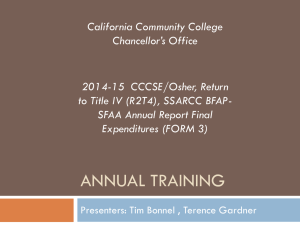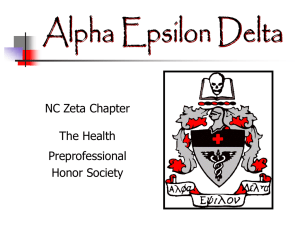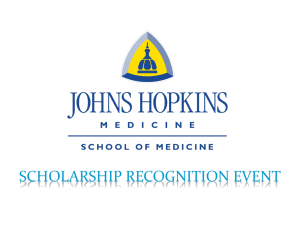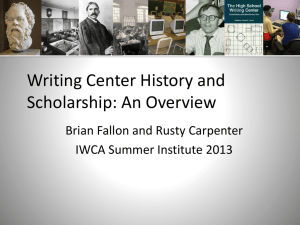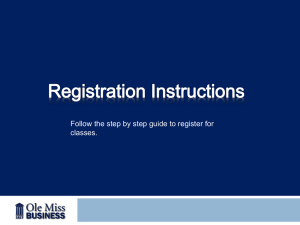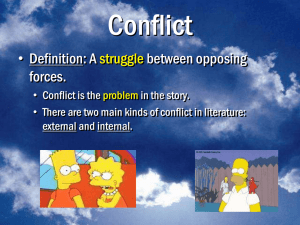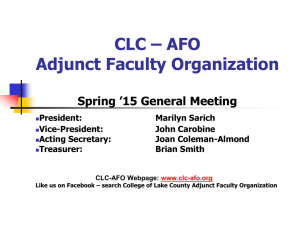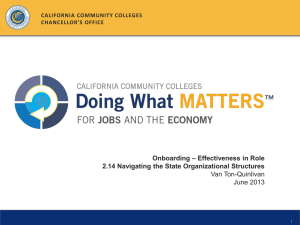Section - California Community Colleges Chancellor`s Office
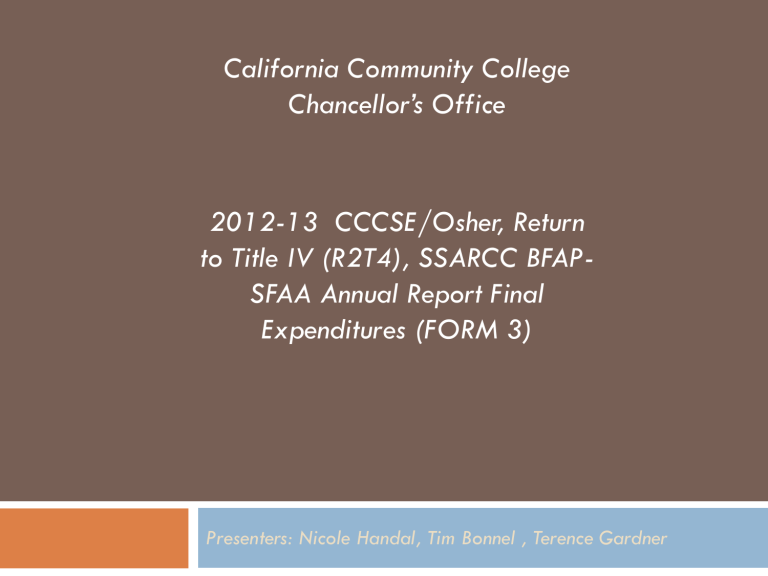
California Community College
Chancellor’s Office
2012-13 CCCSE/Osher, Return to Title IV (R2T4), SSARCC BFAP-
SFAA Annual Report Final
Expenditures (FORM 3)
Presenters: Nicole Handal, Tim Bonnel , Terence Gardner
Today’s Agenda
Introductions
CCCSE/Osher (Nicole Handal)
R2T4 reimbursement reporting (Terence Gardner)
BFAP-SFAA funding formulas and allowable uses (Tim Bonnel
BFAP-SFAA allocations and reporting
Brief background on SSARCC
2012-13 BFAP-SFAA Form 3 Final Expenditures
Entering data by object code
“Validate” Final Expenditures
Address any “error” messages
Address other messages
“Submit to Chancellor’s Office”
Print final expenditures for signatures
Mail SSARCC_FA signature pages to Chancellor’s Office
CCCSE/Osher Reporting
California Community
College Scholarship
Endowment
Annual CCCSE/Osher Report
The 2012-13 CCCSE Scholarship Reporting
Worksheet is an Excel workbook that contains four tabs.
Cash Flow & Selection Process ( blue tab )
Scholarship Recipients ( green tab )
2012-13 Scholarship Award ( yellow tab )
Acknowledgement Form ( red tab )
Annual CCCSE/Osher Report
Cash Flow & Selection Process (
blue tab
)
Cash Flow for Academic Year 2012-13
Cash on Hand Section
This section refers to the cash-on-hand balance from academic year 2011-12; as of July 1, 2012, and as reported in the 2011-12 CCCSE Scholarship Report.
Please refer to the 2012-13 Scholarship Award spreadsheet ( yellow tab ) for the previously reported cashon-hand amount for your college.
If the amount listed on the 2012-13 Scholarship Award spreadsheet does not match your records please contact the
FCCC.
Annual CCCSE/Osher Report
Cash Flow & Selection Process ( blue tab )
Cash Flow for Academic Year 2012-13
2011-12 Distribution from CCCSE Section
This section refers to the amount your college received in scholarship funds in academic year 2012-13, from both the
Initial Gift and the Matching Fund (i.e. College & FCCC
Scholarships).
Please refer to the 2012-13 Scholarship Award spreadsheet ( yellow tab ) for the 2012-13 scholarship distributions from the CCCSE.
If the amounts listed on the 2012-13 Scholarship Award spreadsheet does not match your records please contact the
FCCC.
Annual CCCSE/Osher Report
Cash Flow & Selection Process ( blue tab )
Cash Flow for Academic Year 2012-13
Value of Scholarships Distributed to Students Section
This section refers to the total amount of scholarship funds distributed to students in academic year 2012-13
Annual CCCSE/Osher Report
Cash Flow & Selection Process ( blue tab )
Cash Flow for Academic Year 2012-13
Cash on Hand (as of June 30, 2013) Section
This section refers to the amount of scholarship funds remaining from academic year 2012-13, as of June 30,
2013.
Cash-on-hand amounts require an explanation.
Annual CCCSE/Osher Report
Cash Flow & Selection Process ( blue tab )
Application & Selection Process
This section refers to the Osher scholarship application and selection process at your campus, including the application deadline, the approximate number of applications reviewed, changes made to the process, and donor recognition efforts.
Annual CCCSE/Osher Report
Scholarship Recipients (
green tab
)
This section refers to the detail regarding individual scholarship recipients, including:
Student ID number
New scholarship or renewal
CCC BOG Fee Waiver recipient*
Confirmation that the recipient completed the minimum of 24 degree applicable units prior to the initial disbursement
Amount and date received for each semester
Number of units enrolled in each semester
Annual CCCSE/Osher Report
Informal double-checks section
The error messages in this section indicate that the information reported in the ‘Cash Flow’ ( blue tab ) and
‘Scholarship Recipients’ ( green tab ) sections do not reconcile.
Should these messages appear after completing both sections of the report, please revise the information reported or contact the FCCC for assistance.
Annual CCCSE/Osher Report
Tips regarding the Informal double-checks section
A should equal B (scholarship funds distribution data)
The total amount distributed to students in scholarships, as reported in the Cash Flow worksheet ( blue tab ) should equal the total amount of scholarships distributed to students, as reported in the Scholarship
Recipients worksheet ( green tab ).
C should equal D (cash-on-hand data)
The total funds available for scholarships minus the value of scholarships distributed, as reported in the Cash Flow worksheet ( blue tab ) should equal the total amount of cash on hand from 2012-13, as reported in the Cash Flow worksheet ( blue tab ).
Annual CCCSE/Osher Report
Acknowledgement Form (red tab)
Please scan the completed signed Acknowledgement
Form, and return via email along with electronic copies of the completed report workbook to the FCCC at endowment@foundationccc.org
.
Any questions should be directed to the above email address, or 866-325-3222 ext. 124
Additional resources and information can be found at the following link: http://www.foundationccc.org/WhatWeDo/ScholarshipEn dowment/ResourcesforColleges/tabid/579/Default.aspx
DUE DATE
COB
Thursday, October
31, 2013
Return to Title IV (R2T4) Reimbursement Reporting
R2T4 RESOURCES
R2T4 Reimbursement memo
R2T4 Reimbursement Report spreadsheet
Budget Act Language:
Of the funds appropriated in Schedule (1), Apportionments:
“Up to $500,000 is to reimburse colleges for the costs of federal aid repayments related to assessed fees for fee waiver recipients. This reimbursement only applies to students who completely withdraw from college before the census date pursuant to Section 58508 of Title 5 of the California Code of Regulations.”
Not a mandatory reporting process (college option)
R2T4 Reimbursement Claim Process
The reimbursement system works as follows:
All R2T4 payments to the federal programs that have been made or will be made on behalf of the college for the 2012-13 award-year should be recorded on the spreadsheet provided.
Submit the spreadsheet electronically to the Chancellor’s Office as an attachment to the email on or before Friday, October 4, 2013.
Colleges may receive up to 98% (or a prorated portion based upon claim volume) of the total amount returned to the Federal Title IV programs for students who:
1. Withdrew prior to census; and
2. Were eligible for a BOG Fee Waiver
Institutional reimbursements will be identified as a “Return to
Title IV” line item in the March - 2014 Recalculation (R-1) for adjustments to prior year apportionments and categorical funding recalculations.
Tips and Quality Control
Must provide a student ID (non SSN) for each claim submitted.
Will not be able to accept any files submitted with Social Security Numbers.
Only include payments made to federal SFA program accounts to meet college obligations for returning the portion of assessed fees as required by the federal
Return to Title IV policy.
No student refund obligations should be included on this report at any time, even if the college collects and returns the money to the Title IV programs on behalf of the student.
The instructions for the spreadsheet are included in comment fields built into the sample spreadsheet itself. Do not alter spreadsheet.
Place mouse pointer over any of the column headings, narrative instructions will appear to clarify acceptable values or entries for each column.
Please be sure to enter your college’s three digit MIS code and college name at the top in the cells indicated. Codes may be found on the Chancellor’s Office website at the following URL: http://extranet.cccco.edu/Portals/1/TRIS/MIS/Left_Nav/DED/Appendices/District_&_College_Codes.pdf
Due Date:
COB
Friday
October 4, 2013
BFAP-SFAA Formulas and Allowable Uses
BFAP SFAA - Resources
As information is developed it will be available on the SFA Programs sub-page of the system office website at the following URL: http://extranet.cccco.edu/Divisions/StudentServices/Financial
Aid.aspx
Capacity Funding:
$34.2 Million started in 2003-04 for Increased FA
Staffing and Enhanced FA Service & Capacity:
Increase awareness and participation in student financial aid programs through direct contact with students, potential students and their families.
Increase low-income and disadvantaged student participation in postsecondary education through access to financial aid information, application assistance and funding.
Assist students, prospective students and their families to overcome financial barriers in accessing postsecondary education.
Capacity Funding
(cont’d)
:
Budget Act’s “Supplement, not Supplant,”
Requirements
2012-13 Budget Act amended to:
“… supplement, and shall not supplant, the level of funds allocated for the administration of student financial aid programs during the 2001–02 fiscal year or 2006–07, whichever is greater.”
Based on BFAP Form 3 Annual Report submitted by colleges in the Fall of 2002 and 2007.
Existing Allowable Uses:
BOGFW Manual Section 7.1.2
Funds may be expended solely for financial aid professional, technical, clerical and/or temporary staff (including student help) who report directly to the financial aid director.
Funds may be used for expenses associated with staff training.
Funds may be used for the development and production of financial aid outreach events and materials.
Funds may be used for computer hardware or software necessary for and solely dedicated to the delivery of student financial aid.
Restrictions on Allowable Uses:
BOGFW Manual Section 7.1.2
Funds cannot be used for district operations nor may they be divided among colleges within a district in a manner that differs from the annual allocation to each campus.
No exceptions to these guidelines are allowed without the written approval of the Chancellor’s Office Student Financial Assistance
Programs Coordinator.
Funds may not be used for salaries for personnel at the level of financial aid manager or above.
Funds may not be used for capital outlay or office supplies. The funds may not cover expenditures made or liabilities incurred prior to
July 1 of the applicable fiscal year.
Funds must supplement, not supplant, on-going college expenditures for the administration of student aid.
Allowable Uses
(cont’d)
:
Budget Act provides definitive guidance on “allowable use,” to include:
Costs associated with providing additional SFA staff to provide
“direct contact” with students in an effort to increase both FA participation and student FA program access for low-income and disadvantaged students.
Screening current students for possible financial aid eligibility;
Offering students personal assistance in completing financial aid applications and forms;
Providing information & assistance in completing FA applications in multiple languages;
Increasing financial aid staff to process additional applications and forms.
Exception Form
Fillable PDF form
Request exception to “allowable use”
Request exception to “Maintenance of Effort” (MOE)
Guidelines and clarification
Exception form at: http://extranet.cccco.edu/Divisions/StudentServices
/FinancialAid/SFAPAllocationsReporting.aspx
Communications & Funding Cycles
Preliminary allocation from Governor’s May Revise available early to mid-June
Official Initial Allocations after budget signing
(July?)
P-1 Adjustments in Winter (Jan)
P-2 Adjustments in Spring (May)
R-1 Adjustments in subsequent year Winter (Jan)
Allocation Formulas
BFAP SFAA Base ($0.91)
Minimum $12,500
Guarantee Prior Year 90%
Remaining allocation for colleges eligible for 90% based on fair-share calculation of the colleges BOGFW as a percent of the system total.
Underutilization penalties may apply
BFAP SFAA Capacity (Aug)
Minimum $50,000
No other Minimum Guarantee (i.e. % of Prior year)
Remaining allocation for colleges based upon:
50% allocated on fair-share calculation of the college’s MIS data submissions BOGFW as a percent of the system total 50% allocated on fair-share calculation of the college’s FTES (A-320 report) as a percent of the system total
Underutilization penalties may apply
BFAP 2%
Entire allocation for colleges based upon allocated on fair-share calculation of the college’s MIS data submission for BOGFW award dollars as a percent of the system total
MOE Penalties may apply
Allocation Penalties:
Underutilization if not returned/de-obligated:
$ for $ equal to unutilized funds in excess of one percent (1%) of the total BFAP SFAA allocation
Failure to meet FA MOE Spending Requirements:
$ for $ assessment for the maintenance shortfall against
2% allocation
BFAP-SFAA Allocations and Reporting
Reporting
Adhoc reporting as required/requested
BFAP Form 2 due in Mar/Apr of current year to:
Release Funds, or
Confirm Spending, and
Request funds
BFAP Form 3 (SSARCC_FA) due in October of subsequent year to:
Close out fiscal year
Report full fiscal year actual expenditures
Report MOE compliance/non-compliance
Additional data as requested/required
Form 2
Carefully review spending to determine if all funds will be utilized.
Only opportunity to release any funds that will be unspent
WITHOUT the college incurring a penalty.
Future allocation of a college returning funds WILL NOT BE
IMPACTED because a portion of the funds were returned.
Request release of outreach event holdback for Spring
Financial Aid Awareness activities.
Request for additional BFAP allocation (contingent on availability of released funds).
Must complete the appropriate box(es) on form 2, page 3 and write a brief explanation as to how the funds will be spent if awarded.
Signatures from FA Director and CBO (college or district)
System Office Support & Intervention
Contact us if:
Having difficulty securing approval of budget for allowable use
Potentially at risk of not meeting MOE due to spending/budget restrictions
BFAP-SFAA Funding is redirected outside of FA operations or allowable use purpose
Need consultation or response on strategy or exceptions
Contacted by media or legislature regarding your FA program participation or spending.
SSARCC
Student Services
Automated Reporting for Community College
What Is SSARCC?
SSARCC = Student Services Automated Reporting for Community Colleges
Developed or being developed for most student service categorically funded programs
A web-based computer application used to report key fiscal data points to the Chancellor’s Office
(final expenditures for BFAP-SFAA)
Purpose
Standardize college reporting for FA Program expenditures.
Allow for more efficient review time by college and by Chancellor’s Office
Allow Chancellor’s Office to have electronic access to statewide budget data
Extracted SSARCC data can be used locally and at the State level
Creates audit trail for categorical compliance
SSARCC_FA Timeline
Available now : SSARCC_FA reports prepopulated with prior year staffing for less data entry
August 22, 28, and September 11, 2013 : CCC Confer trainings on SSARCC_FA final expenditure screens
Available now : Colleges may use SSARCC_FA to submit 2012-
13 final expenditures (with hard-copy signature pages scanned or mailed)
Friday, October 18, 2013 : Deadline for Colleges to submit
2012-13 SSARCC_FA final expenditures.
SSARCC_FA
Collects information on your college’s expenditure related to the administration of Student Financial Aid Programs and includes:
District/College Maintenance of Effort (MOE) expenditures
General Fund and Other Sources
BFAP-SFAA base allocation expenditures
BFAP-SFAA Capacity funding allocation expenditures
Enclosure 1 – 2012-13 Annual Board Financial Assistance Program
Student Financial Aid Administration (BFAP-SFAA) Expenditure
Report (Form #3 in SSARCC portal)
Enclosure 2 Memo and Attachments (PDF format) including:
2012-13 BFAP-SFAA Allocation as of P-2
District/college MOE requirements for 2012-13
Board of Governors Expenditure Guidelines for BFAP-SFAA Allocations
2012-13 Budget Act Language regarding BFAP-SFAA funding.
Object Code Structure
1000 = Certificated Salaries
2000 = Classified Salaries
3000 = Employment Benefits
4000 = Supplies & Equipment
5000 = Other Operating Expenses
6000 = Capital Outlay
Instructions
Prepare spending report to reflect the entire augmentation unless a decision was reached to return some portion of the augmentation on the BFAP Form
#2.
Report requires general summary by object code of:
Institutional general fund support,
Other sources of support and
Base BFAP allocation spending by object code.
Report requires detailed line item spending by object code for the augmentation.
SSARCC Screens
Reminders & Suggestions:
Title IV Audit Expenses
FWS or CWWS employed in FA
Not permitted to include any staff in categorical funding or in the MOE that do not report to the FA Director.
No office supplies from categorical funding
No maintenance contracts on office equipment from categorical
No office equipment other than allowable computers and peripherals from categorical funding.
Only hardware/software solely dedicated and used in and for financial aid is permitted from categorical or included in MOE.
Reminders & Suggestions:
cont’d
Larger dollar line items should provide a thorough explanation of expenditure (categorical or MOE)
Promotional items should specify the type and purpose and should not be rolled up into an aggregate number for the year. Each item or invoice should be reflected separately. The use of these items are for FA outreach and awareness not general outreach and awareness.
Food/refreshment cost should specify the purpose and or event number served and whether the event was for FA only or a combination of groups/general students. They should not be rolled up into an aggregate number for the year but reported separately.
Reminders & Suggestions: cont’d
More detail in the explanation explaining the purpose of the expenditure, the equipment, or nature or strategy will result in less rejected reports and calls/emails for clarification.
Time basis of positions will be a focus this year as we definitely want to be able to compare staffing year to year.
Exception will be tracked and as a result a failure to secure approval could result in disallowed expenses and repayment of categorical funds.
Future developments in SSARCC-FA:
User enhancements:
What does your wish list include?
SSARCC-FA@cccco.edu
Our wish list includes:
Inclusion of a contact email/direct line for the preparer/submitter so we know who to communicate with
A flag for incomplete/unacceptable entries
A note field for communicating on specific issues or concerns
A field to identify who is reviewing/commenting or rejecting the report for the CCCCO
“Validate” Final Expenditures
You should use this to double-check work prior to submitting
Address any “error” messages that appear
“View Draft Expenditure Report”
Do this when:
You think you’re ready to submit to Chancellor’s
Office
Ready for review by local district/college staff before submitting to Chancellor’s Office
You can still go back into screens to make changes to data
“Submit to Chancellor’s Office”
“Submit” after error messages have been addressed and after appropriate local staff have reviewed
“ Submit” locks final expenditure screens
“Submit” means final expenditures are officially transmitted to Chancellor’s Office
To unlock screens, send email to SSARCC help desk: ssarcc-fa@cccco.edu
Printing SSARCC_FA Final Expenditures
Signature Pages
This is done after you have “submitted” to Chancellor’s
Office; to print signature pages, do the following:
1. Click on “view expenditure report”
2. In the “select a format” window, click on the down arrow and then click on “PDF”
3. Click on “export”
4. Wait for report to appear on your computer screen
5. Print out budget/signature page & obtain required original signatures & mail to Chancellor’s Office
Where Do I Go for Help?
ssarcc-fa@cccco.edu
Due Date:
COB
Friday
October 18, 2013
